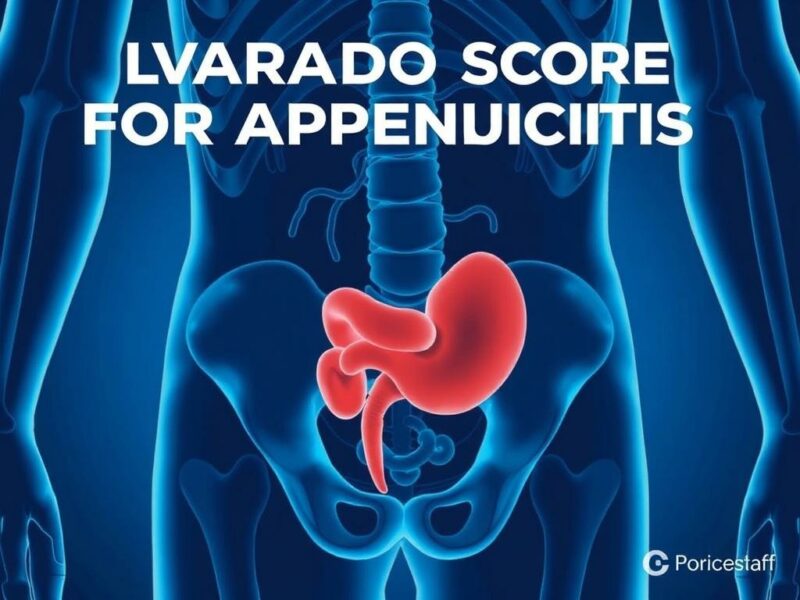Appendicitis is one of the most common causes of abdominal pain that brings patients to the emergency room. Yet, diagnosing appendicitis accurately and swiftly can sometimes be challenging even for experienced clinicians. This is where the Alvarado Score for Appendicitis comes in—a clinical scoring system designed to help healthcare providers decide whether a patient likely has appendicitis and what the next steps should be. In this article, we will explore what the Alvarado Score is, how it works, why it’s important, and how it fits into modern medical practice. Whether you are a medical student, a healthcare professional, or simply someone curious about medical tools, this comprehensive guide will walk you through everything you need to know about the Alvarado Score for Appendicitis.
What is the Alvarado Score for Appendicitis?

The Alvarado Score, sometimes called the MANTRELS Score, is a clinical scoring system used to assess the likelihood that a patient’s abdominal pain is caused by appendicitis. Developed in the 1980s, it aims to provide a quick, easy-to-use way for clinicians to evaluate patients based on a combination of symptoms, physical findings, and simple laboratory tests. The score helps in risk stratification—essentially categorizing patients into groups based on how likely they are to have appendicitis—and guides further diagnostic or treatment decisions. This is particularly useful in settings where immediate imaging or surgical resources might not be readily available.
How Does the Alvarado Score Work?
The Alvarado Score is based on eight components that are derived from a patient’s clinical presentation. Each component is assigned a point value, and the total score can range from 0 to 10. The components of the Alvarado Score for Appendicitis include symptoms such as migratory right iliac fossa pain and anorexia, signs like tenderness and rebound tenderness in the right lower quadrant (RLQ), and laboratory parameters like leukocytosis and a shift to the left of neutrophils.
| Component | Description | Points Allocated |
|---|---|---|
| Symptoms | Migratory right iliac fossa pain | 1 |
| Symptoms | Anorexia (loss of appetite) | 1 |
| Symptoms | Nausea and vomiting | 1 |
| Signs | Tenderness in right lower quadrant | 2 |
| Signs | Rebound tenderness | 1 |
| Signs | Elevated temperature (fever) | 1 |
| Laboratory | Leukocytosis (high white blood cell count) | 2 |
| Laboratory | Shift to the left (neutrophilia) | 1 |
By tallying the points allocated according to the presence or absence of each component, the clinician gets a total score that helps predict the probability of appendicitis.
Interpreting the Alvarado Score: What Do the Numbers Mean?
Once the score has been calculated, the clinician uses it to make key decisions:
- Score 1-4: Low probability of appendicitis. Patients in this range are unlikely to have appendicitis. This generally means other causes of abdominal pain should be investigated, and the patient may be safely observed or discharged.
- Score 5-6: Equivocal or moderate probability. This “gray zone” usually suggests the need for further diagnostic tests like ultrasound or computed tomography (CT) scans, or close clinical observation to avoid unnecessary surgery or missing the diagnosis.
- Score 7-10: High probability of appendicitis. A high score alerts the clinician that appendicitis is very likely, and surgery or more rapid intervention should be considered to prevent complications like rupture.
This straightforward interpretation helps reduce unnecessary imaging and negative appendectomies while ensuring prompt treatment when warranted.
Breaking Down the Components: Why Each Point Matters
Let’s explore a bit more why each element of the Alvarado Score holds clinical significance:
Migratory Right Iliac Fossa Pain
One of the hallmark features of appendicitis is the shift of abdominal pain from the central abdomen (around the umbilicus) to the right lower quadrant. This occurs as inflammation irritates the peritoneum near the appendix. Migratory pain is assigned 1 point because it often indicates early appendicitis.
Anorexia and Nausea/Vomiting
Loss of appetite and gastrointestinal upset are common but nonspecific symptoms. Still, their presence adds weight to the suspicion of appendicitis within the clinical context.
Tenderness and Rebound Tenderness
Tenderness in the RLQ is the most significant physical finding and is given 2 points—reflecting its strong association with localized inflammation of the appendix. Rebound tenderness indicates peritoneal irritation, which is a bit more specific and suggests the inflammation might be progressing.
Elevated Temperature
A low-grade fever is typical in appendicitis because it is an inflammatory condition. It is an important sign but less specific, hence the allocation of just 1 point.
Leukocytosis and Left Shift
Blood tests show an elevated white blood cell count and an increase in immature neutrophils (left shift) during infection, making these laboratory signs key components of the score.
Advantages of Using the Alvarado Score for Appendicitis
The Alvarado Score offers several clear benefits:
- Easy to use: It does not require sophisticated equipment or imaging and can be completed rapidly at bedside.
- Cost-effective: Helps reduce unnecessary CT scans or ultrasounds, saving healthcare resources and patient exposure to radiation.
- Facilitates decision-making: Provides a structured, objective framework for diagnosis, minimizing subjective variability among clinicians.
- Widely validated: Numerous studies worldwide have assessed its reliability, making it a trusted clinical tool.
Limitations and Criticisms of the Alvarado Score
Despite its usefulness, the Alvarado Score is not perfect. It has some limitations:
- Variable accuracy in different populations: For example, the score performs differently in children, women of reproductive age, and elderly patients, who often have atypical presentations.
- Does not replace clinical judgment: It is an aid, not a definitive test. Surgeons and clinicians must interpret the score in the context of the whole clinical picture.
- Less reliable in pregnancy: Physiological changes and overlapping symptoms reduce its predictive value.
For these reasons, clinicians often combine the Alvarado Score with imaging and other diagnostic methods to ensure accurate diagnosis.
How the Alvarado Score Fits Into Modern Appendicitis Diagnosis
Today, appendicitis diagnosis commonly involves a mix of clinical examination, laboratory tests, and imaging such as ultrasound or CT scans. While imaging improves diagnostic accuracy, it is not always immediately accessible, especially in resource-limited settings. The Alvarado Score serves as a valuable initial screening tool that can guide the use of more advanced diagnostics.
Integration With Imaging
For example, a patient with a moderate score of 5 or 6 might undergo an ultrasound or CT scan to confirm the diagnosis before proceeding to surgery. Alternatively, a low score may allow safe discharge or outpatient follow-up without imaging, and a high score might prompt surgical consultation directly.
Use in Different Patient Groups
In children, modifications of the Alvarado Score are often employed or supplemented with pediatric-specific tools to improve accuracy. Similarly, in women, gynecological conditions can mimic appendicitis, so the score must be interpreted carefully alongside pelvic exams and imaging.
Practical Example: Using the Alvarado Score for Appendicitis in a Clinical Scenario
Imagine a 23-year-old man presenting to the emergency department with 12 hours of abdominal pain. Initially, it was around his belly button but has now moved to the right lower quadrant. He has lost his appetite and vomited once. On examination, he has tenderness and rebound tenderness in the RLQ and a low-grade fever of 38 °C. His blood test shows a white blood cell count elevated at 14,000/μL with a left shift.
Let’s tally his Alvarado Score:
- Migratory right iliac fossa pain: 1 point
- Anorexia: 1 point
- Nausea/vomiting: 1 point
- RLQ tenderness: 2 points
- Rebound tenderness: 1 point
- Elevated temperature: 1 point
- Leukocytosis: 2 points
- Left shift: 1 point
Total Score: 10 points.
This score suggests a very high probability of appendicitis, warranting urgent surgical consultation.
Other Clinical Scoring Systems: Comparing with the Alvarado Score for Appendicitis
While the Alvarado Score is popular, it is not the only clinical scoring system for appendicitis. Some alternatives include:
| Scoring System | Key Features | Strengths | Limitations |
|---|---|---|---|
| Pediatric Appendicitis Score (PAS) | Specifically designed for children, includes symptoms, signs, and lab data | Better accuracy in pediatric cases | Not validated in adults |
| Appendicitis Inflammatory Response (AIR) Score | Focuses more on inflammatory markers and CRP levels | Good for distinguishing complicated from uncomplicated appendicitis | More complex; requires lab data that may not be rapidly available |
| RIPASA Score | Developed for Asian populations, includes clinical and demographic data | Higher sensitivity and specificity in certain populations | Less used outside target populations |
Depending on the healthcare setting and patient population, clinicians may choose to use the Alvarado Score for appendicitis or one of these alternatives, or even combine them to improve diagnostic accuracy.
Tips for Patients: What to Know if You Suspect Appendicitis
If you or someone you know is experiencing abdominal pain, it’s important to understand some key points:
- Seek medical attention promptly: Appendicitis can progress quickly; early evaluation reduces the risk of complications.
- Describe your symptoms clearly: Mention if pain has migrated, if you feel nauseous, or have lost your appetite.
- Remember the Alvarado Score is for doctors: This tool helps them decide on next steps, but self-diagnosis isn’t recommended.
- Imaging or tests may be needed: Even if symptoms seem mild, healthcare providers might order ultrasound or CT scan.
- Prompt treatment is key: Appendicitis usually requires surgery, and delaying care can lead to serious complications.
Future Developments: Where is the Alvarado Score for Appendicitis Headed?
Recent advancements in medicine, including artificial intelligence and enhanced imaging techniques, are changing how appendicitis is diagnosed and managed. However, the simplicity and practicality of the Alvarado Score keep it relevant. Researchers are exploring ways to integrate this score into electronic health records and decision support systems, potentially making it even easier for clinicians to use and reducing diagnostic errors.
Moreover, combining the Alvarado Score with novel biomarkers and bedside ultrasound might improve diagnostic pathways, especially in complicated or atypical cases. In resource-poor settings, the Alvarado Score remains an invaluable tool, ensuring patients receive timely diagnosis and care without the need for expensive technology.
Summary Table: Alvarado Score Components and Their Points
| Category | Component | Points |
|---|---|---|
| Symptoms | Migratory RLQ pain | 1 |
| Symptoms | Anorexia | 1 |
| Symptoms | Nausea/vomiting | 1 |
| Signs | RLQ tenderness | 2 |
| Signs | Rebound tenderness | 1 |
| Signs | Elevated temperature >37.5 °C | 1 |
| Laboratory | Leukocytosis (WBC >10,000/μL) | 2 |
| Laboratory | Shift to the left (neutrophilia) | 1 |
Final Thoughts on the Alvarado Score for Appendicitis
The Alvarado Score for Appendicitis remains a powerful, practical, and easy-to-use clinical tool that has stood the test of time. By combining common clinical features, signs, and simple lab results into a straightforward scoring system, it aids clinicians in diagnosing appendicitis quickly and efficiently. While it is not perfect and should be integrated thoughtfully with other diagnostic methods and clinical judgment, its cost-effectiveness and ease of use have made it a staple, especially in settings with limited resources. Whether used in emergency departments, primary care, or rural clinics, the Alvarado Score continues to improve patient outcomes by guiding timely decision-making and helping avoid unnecessary procedures. For anyone encountering abdominal pain, understanding the basics of this scoring system can help appreciate the careful assessment their healthcare provider performs—and why timely intervention is essential for appendicitis.



